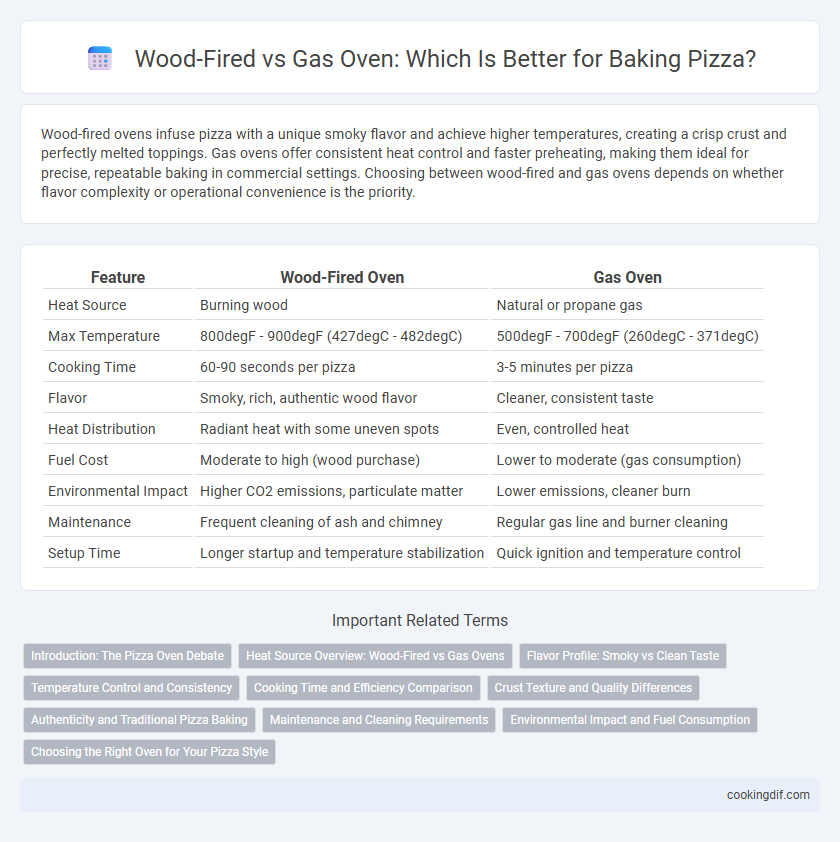Wood-fired ovens infuse pizza with a unique smoky flavor and achieve higher temperatures, creating a crisp crust and perfectly melted toppings. Gas ovens offer consistent heat control and faster preheating, making them ideal for precise, repeatable baking in commercial settings. Choosing between wood-fired and gas ovens depends on whether flavor complexity or operational convenience is the priority.
Table of Comparison
| Feature | Wood-Fired Oven | Gas Oven |
|---|---|---|
| Heat Source | Burning wood | Natural or propane gas |
| Max Temperature | 800degF - 900degF (427degC - 482degC) | 500degF - 700degF (260degC - 371degC) |
| Cooking Time | 60-90 seconds per pizza | 3-5 minutes per pizza |
| Flavor | Smoky, rich, authentic wood flavor | Cleaner, consistent taste |
| Heat Distribution | Radiant heat with some uneven spots | Even, controlled heat |
| Fuel Cost | Moderate to high (wood purchase) | Lower to moderate (gas consumption) |
| Environmental Impact | Higher CO2 emissions, particulate matter | Lower emissions, cleaner burn |
| Maintenance | Frequent cleaning of ash and chimney | Regular gas line and burner cleaning |
| Setup Time | Longer startup and temperature stabilization | Quick ignition and temperature control |
Introduction: The Pizza Oven Debate
Wood-fired pizza ovens produce intense heat reaching up to 900degF, creating a crispy crust with a smoky flavor prized in traditional Neapolitan pizzas. Gas ovens offer consistent temperature control and faster preheating, ideal for commercial settings requiring efficiency and uniform cooking. Each oven type influences the pizza's texture and taste, making the choice essential based on desired flavor profiles and operational needs.
Heat Source Overview: Wood-Fired vs Gas Ovens
Wood-fired ovens use burning hardwood to create intense, radiant heat that can reach temperatures up to 900degF, imparting a unique smoky flavor and crispy crust to the pizza. Gas ovens utilize natural gas or propane for consistent, controllable heat and faster preheating times, offering precise temperature regulation between 500degF and 700degF. The choice of heat source significantly impacts cooking style, flavor development, and oven maintenance.
Flavor Profile: Smoky vs Clean Taste
Wood-fired ovens impart a distinct smoky flavor to pizza, enhancing the crust with subtle charred notes and adding depth to the overall taste. Gas ovens produce a cleaner, more neutral flavor profile, allowing the natural ingredients to shine without additional smokiness. Choosing between the two depends on whether you prefer a robust, smoky character or a pure, unadulterated taste in your pizza.
Temperature Control and Consistency
Wood-fired ovens reach higher temperatures, often exceeding 900degF, producing a distinctive char and smoky flavor, but temperature control can be challenging due to variable wood fuel and airflow. Gas ovens offer precise temperature regulation, maintaining consistent heat levels between 500degF and 700degF, ensuring uniform baking results and repeatability. Consistent temperature in gas ovens reduces the risk of uneven cooking, while wood-fired ovens demand skilled management to balance intense heat and cooking time.
Cooking Time and Efficiency Comparison
Wood-fired ovens reach temperatures of 800-900degF, enabling pizzas to cook in just 90 seconds, while gas ovens typically operate at 500-700degF, requiring 4-6 minutes per pizza. The rapid heat retention and intense heat of wood-fired ovens promote a crisp crust and distinctive smoky flavor, whereas gas ovens offer more consistent temperature control and fuel efficiency. Gas ovens generally consume less energy and produce fewer emissions, making them more efficient for extended cooking sessions despite the longer bake times.
Crust Texture and Quality Differences
Wood-fired ovens produce pizzas with a uniquely charred, smoky crust and a crisp exterior while maintaining a chewy interior due to their intense heat, often exceeding 800degF. Gas ovens provide more consistent temperature control, resulting in a uniformly baked crust, though lacking the distinctive smoky aroma and slightly blistered texture typical of wood-fired pizzas. The choice between wood-fired and gas ovens significantly influences the pizza's crust texture and overall quality, with wood-fired preferred for artisanal, rustic styles and gas favored for predictable, even baking.
Authenticity and Traditional Pizza Baking
Wood-fired ovens provide an authentic, traditional pizza baking experience that infuses pies with a distinctive smoky flavor and perfectly charred crust, characteristic of classic Italian pizzas. The high temperatures, often exceeding 800degF, allow for faster cooking times and a unique texture that gas ovens struggle to replicate. Gas ovens offer greater temperature control and convenience but lack the wood fire's ability to produce the same depth of flavor and artisanal quality prized in traditional pizza making.
Maintenance and Cleaning Requirements
Wood-fired ovens demand frequent cleaning to remove ash and soot buildup, requiring more intensive maintenance to preserve the oven's efficiency and longevity. Gas ovens offer easier upkeep with simpler cleaning processes and fewer residues, making them more convenient for regular use. Proper maintenance of either oven type ensures optimal baking temperature and consistent pizza quality.
Environmental Impact and Fuel Consumption
Wood-fired ovens produce higher carbon emissions due to the combustion of wood, contributing to deforestation and air pollution. Gas ovens emit less CO2 and offer greater fuel efficiency, reducing overall environmental impact. Choosing gas ovens supports sustainable energy use, while wood-fired ovens require careful sourcing of wood to minimize environmental harm.
Choosing the Right Oven for Your Pizza Style
Wood-fired ovens reach higher temperatures up to 900degF, creating a crisp, charred crust ideal for Neapolitan-style pizzas with a smoky flavor. Gas ovens offer more temperature control and consistent heat, making them suitable for thinner, New York-style pizzas that require even baking. Selecting the right oven depends on your preferred pizza style and desired texture, balancing intense heat and flavor with temperature precision.
Wood-fired vs gas oven for baking Infographic

 cookingdif.com
cookingdif.com